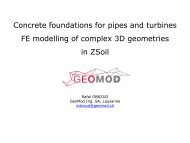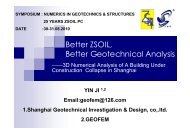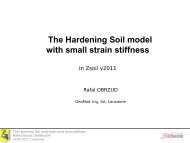Hardening Soil model with small strain stiffness - Zace Services Ltd.
Hardening Soil model with small strain stiffness - Zace Services Ltd.
Hardening Soil model with small strain stiffness - Zace Services Ltd.
- No tags were found...
You also want an ePaper? Increase the reach of your titles
YUMPU automatically turns print PDFs into web optimized ePapers that Google loves.
<strong>Hardening</strong> <strong>Soil</strong> <strong>model</strong> <strong>with</strong> <strong>small</strong> <strong>strain</strong> <strong>stiffness</strong>Andrzej TrutyZACE <strong>Services</strong>revised 15.09.2008Andrzej Truty ZACE <strong>Services</strong><strong>Hardening</strong> <strong>Soil</strong> <strong>model</strong> <strong>with</strong> <strong>small</strong> <strong>strain</strong> <strong>stiffness</strong>
Introduction<strong>Hardening</strong> <strong>Soil</strong> (HS) and <strong>Hardening</strong> <strong>Soil</strong>-<strong>small</strong> (HS-<strong>small</strong>)<strong>model</strong>s are designed to reproduce basic phenomena exhibitedby soils:densification<strong>stiffness</strong> stress dependencyplastic yieldingdilatancystrong <strong>stiffness</strong> variation <strong>with</strong> growing shear <strong>strain</strong> amplitudein the regime of <strong>small</strong> <strong>strain</strong>s (γ = 10 −6 to γ = 10 −3 )this phenomenon plays a crucial role for <strong>model</strong>ing deepexcavations and soil-structure interaction problemsNB. This <strong>model</strong> is limited to monotonic loadsAndrzej Truty ZACE <strong>Services</strong><strong>Hardening</strong> <strong>Soil</strong> <strong>model</strong> <strong>with</strong> <strong>small</strong> <strong>strain</strong> <strong>stiffness</strong>
IntroductionHS <strong>model</strong> was initially formulated by Schanz, Vermeer andBonnier (1998, 1999) and then enhanced by Benz (2006)Current implementation is slightly modified <strong>with</strong> respect tothe theory given by Benz:simplified treatment of dilatancy for the <strong>small</strong> <strong>strain</strong> version(HS-<strong>small</strong>)modified hardening law for preconsolidation pressureThis <strong>model</strong> seems to be one of the simplest in the class of<strong>model</strong>s designed to handle <strong>small</strong> <strong>strain</strong> <strong>stiffness</strong>It consists of the two plastic mechanisms, shear and volumetricSmall <strong>strain</strong> <strong>stiffness</strong> is incorporated by means of nonlinearelasticity which includes hysteretic effectsAndrzej Truty ZACE <strong>Services</strong><strong>Hardening</strong> <strong>Soil</strong> <strong>model</strong> <strong>with</strong> <strong>small</strong> <strong>strain</strong> <strong>stiffness</strong>
Notion of tangent and secant <strong>stiffness</strong> moduliInitial <strong>stiffness</strong> modulus E oUnloading-reloading modulus E urSecant <strong>stiffness</strong> modulus at 50 % of the ultimate deviatoricstress q f0250q [kpa]200150100501E o1 E 50q 50E ur1q f0.5 q fσ 3 =constq un0 0.05 0.1 0.15 0.2 0.25EPS-1 [-]Remark: All classical soil <strong>model</strong>s require specification of E urmodulus (Cam-Clay, Cap etc..)Andrzej Truty ZACE <strong>Services</strong><strong>Hardening</strong> <strong>Soil</strong> <strong>model</strong> <strong>with</strong> <strong>small</strong> <strong>strain</strong> <strong>stiffness</strong>
Stiffness-<strong>strain</strong> relation for soils (G/G o (γ))G - current secant shear modulusG o - shear modulus for very <strong>small</strong> <strong>strain</strong>sAtkinson 1991Andrzej Truty ZACE <strong>Services</strong><strong>Hardening</strong> <strong>Soil</strong> <strong>model</strong> <strong>with</strong> <strong>small</strong> <strong>strain</strong> <strong>stiffness</strong>
Notion of treshold shear <strong>strain</strong> γ 07GTo describe the shape of (γ) curve an additionalG ocharacteristic point is neededIt is common to specify the shear <strong>strain</strong> γ 0.7 at which ratioGG o= 0.70.7γ 07Andrzej Truty ZACE <strong>Services</strong><strong>Hardening</strong> <strong>Soil</strong> <strong>model</strong> <strong>with</strong> <strong>small</strong> <strong>strain</strong> <strong>stiffness</strong>
Dynamic vs static modulusRelation between ”static” Young modulus E s , obtained fromstandard triaxial test at axial <strong>strain</strong> ε 1 ≈ 10 −3 , and ”dynamic”Young modulus (the one at very <strong>small</strong> <strong>strain</strong>s) E d = E o isshown in diagram published by Alpan (1970) (after Benz)100EEdsRocks10cohesive soilsgranular soilsE s[kPa]11000 10000 100000 1000000Andrzej Truty ZACE <strong>Services</strong><strong>Hardening</strong> <strong>Soil</strong> <strong>model</strong> <strong>with</strong> <strong>small</strong> <strong>strain</strong> <strong>stiffness</strong>
HS <strong>model</strong>: general conceptDouble hardening elasto-plastic <strong>model</strong> (Schanz, Vermeer,Benz)Nonlinear elasticity for stress paths penetrating the interior ofthe elastic domain600q [kPa]500400300200Cap surface10000 100 200 300 400 500p [kPa]Graphical representation of shear mechanism and cap surfaceAndrzej Truty ZACE <strong>Services</strong> <strong>Hardening</strong> <strong>Soil</strong> <strong>model</strong> <strong>with</strong> <strong>small</strong> <strong>strain</strong> <strong>stiffness</strong>
HS <strong>model</strong>: shear mechanismDuncan-Chang <strong>model</strong> as the origin for shear mechanism250q fq [kPa]200150100500E 50½ q f11M-C limit0 0.01 0.02 0.03 0.04 0.05eps-1E urAndrzej Truty ZACE <strong>Services</strong><strong>Hardening</strong> <strong>Soil</strong> <strong>model</strong> <strong>with</strong> <strong>small</strong> <strong>strain</strong> <strong>stiffness</strong>
Stiffness stress dependencyRemarksE ur = E refurE 50 = E ref50( σ∗3 + c cotφσ ref + c cotφ( σ∗3 + c cotφσ ref + c cotφ) m) m1 Stiffness degrades <strong>with</strong> decreasing σ 3 up to σ 3 = σ L (bydefault we assume σ L =10 kPa)Andrzej Truty ZACE <strong>Services</strong><strong>Hardening</strong> <strong>Soil</strong> <strong>model</strong> <strong>with</strong> <strong>small</strong> <strong>strain</strong> <strong>stiffness</strong>
Extension to <strong>small</strong> <strong>strain</strong>: new ingredientsTo extend standard HS <strong>model</strong> to the range of <strong>small</strong> <strong>strain</strong> Benzintroduced few modifications:1 Strain dependency is added to the stress-<strong>strain</strong> relation, forstress paths penetrating the elastic domain2 The modified Hardin-Drnevich relationship is used to relatecurrent secant shear modulus G and equivalent monotonicshear <strong>strain</strong> γ hist3 Reversal points are detected <strong>with</strong> aid of deviatoric <strong>strain</strong>history second order tensor H ij ; in addition the currentequivalent shear <strong>strain</strong> γ hist is computed by using this tensorAndrzej Truty ZACE <strong>Services</strong><strong>Hardening</strong> <strong>Soil</strong> <strong>model</strong> <strong>with</strong> <strong>small</strong> <strong>strain</strong> <strong>stiffness</strong>
How does it work ?N-1NN+1plot from paper by Ishihara 1986At step N : γ histN−1 = 8 × 10 −5 γ histN = 10 −4At step N + 1 : γ histN = 0 γ histN+1 = 2 × 10 −5Primary loading: γ histN+1 > γhistmaxUnloading/reloading: γ histN+1 ≤ γ maxHardin-Drnevich law: G =histG o1 + a γ histγ 0.7(secant modulus)Andrzej Truty ZACE <strong>Services</strong><strong>Hardening</strong> <strong>Soil</strong> <strong>model</strong> <strong>with</strong> <strong>small</strong> <strong>strain</strong> <strong>stiffness</strong>
Shear tangent modulus cut-offGG urγ cγ c = γ 0.7aAndrzej Truty ZACE <strong>Services</strong>(√ )Go− 1G ur<strong>Hardening</strong> <strong>Soil</strong> <strong>model</strong> <strong>with</strong> <strong>small</strong> <strong>strain</strong> <strong>stiffness</strong>γ
Setting initial state variables: γ PSoGiven: σ o , OCRFind: γ PSand p coo and p co0600q [kPa]500400300200100Shear mechanismCap surfaceσ οσ SR0 100 200 300 400 500p [kPa]Procedure:Set effective stress state at the SR pointσySR = σ yo OCRσxSR = σzSR = σ y KoSRAndrzej Truty ZACE <strong>Services</strong><strong>Hardening</strong> <strong>Soil</strong> <strong>model</strong> <strong>with</strong> <strong>small</strong> <strong>strain</strong> <strong>stiffness</strong>
Setting initial state variables: γ PSoand p co600q [kPa]500400300200100Shear mechanismCap surfaceσ οσ SR00 100 200 300 400 500p [kPa]Procedure:For given σ SR state compute γoPSf 1 = 0from plastic conditionFor given σ SR state compute p co from plastic condition f 2 = 0Andrzej Truty ZACE <strong>Services</strong><strong>Hardening</strong> <strong>Soil</strong> <strong>model</strong> <strong>with</strong> <strong>small</strong> <strong>strain</strong> <strong>stiffness</strong>
Setting initial state variables: γ PSoand p coRemarks= KoNC(approximate Jaky’s formula)1 K SRo2 K SRo≈ 1 − sin(φ) in the standard applications= 1 for case of isotropic consolidation (used in triaxialtesting for instance)3 For sands notion of preconsolidation pressure is not asmeaningful as for cohesive soils hence one may assumeOCR=1 and effect of density will be embedded in H and MparametersAndrzej Truty ZACE <strong>Services</strong><strong>Hardening</strong> <strong>Soil</strong> <strong>model</strong> <strong>with</strong> <strong>small</strong> <strong>strain</strong> <strong>stiffness</strong>
Setting M and H parameters based on oedometric test600500σq [kPa]400q*300200100p*00 100 200 300 400 500p [kPa]σ ref 1oedE oedεAndrzej Truty ZACE <strong>Services</strong><strong>Hardening</strong> <strong>Soil</strong> <strong>model</strong> <strong>with</strong> <strong>small</strong> <strong>strain</strong> <strong>stiffness</strong>
Material propertiesParameter Unit HS-standard HS-<strong>small</strong>Eur ref [kPa] yes yesE50 ref [kPa] yes yesσ ref [kPa] yes yesm [—] yes yesν ur [—] yes yesR f [—] yes yesc [kPa] yes yesφ [ o ] yes yesψ [ o ] yes yese max [—] yes yesf t [kPa] yes yesD [—] yes yesM [—] yes yesH [kPa] yes yesOCR/q POP [—/kPa] yes yesEo ref [kPa] no yesγ 0.7 [—] no yesAndrzej Truty ZACE <strong>Services</strong><strong>Hardening</strong> <strong>Soil</strong> <strong>model</strong> <strong>with</strong> <strong>small</strong> <strong>strain</strong> <strong>stiffness</strong>
Converting MC to HS <strong>model</strong>: indentation problemAssumption: q = 0.5 q ultGiven: E for MC <strong>model</strong> and E urE 50= ...,E 50E oed= ...1mAq = 0.5 q ult10m10mFind: E refur , M and H for standard HS <strong>model</strong>Andrzej Truty ZACE <strong>Services</strong><strong>Hardening</strong> <strong>Soil</strong> <strong>model</strong> <strong>with</strong> <strong>small</strong> <strong>strain</strong> <strong>stiffness</strong>
Example: triaxial test on dense Hostun sand65.55120000SIG-1 / SIG-3 [kPa]4.543.532.5HS-stdHS-<strong>small</strong>G [kPa]100000800006000040000HS-stdHS-<strong>small</strong>21.520000100 0.02 0.04 0.06 0.08 0.10.00001 0.0001 0.001 0.01 0.1 1-EPS-Y [-]EPS-X - EPS-Y [-](a) σ 1σ 3(ε 1 ) (Z <strong>Soil</strong>)(b) G(γ) (Z <strong>Soil</strong>)43.50 0.02 0.04 0.06 0.08 0.10.08SIG-1 / SIG-3 [kPa]32.52HS-stdHS-<strong>small</strong>-EPS-V [-]0.070.060.050.040.030.02HS-stdHS-<strong>small</strong>1.50.0101-0.010 0.002 0.004 0.006 0.008 0.01-EPS-Y [-]-0.02-EPS-Y [-](c) σ 1σ 3(ε 1 ) (zoom) (Z <strong>Soil</strong>)(d) ε v (ε 1 ) (Z <strong>Soil</strong>)Andrzej Truty ZACE <strong>Services</strong><strong>Hardening</strong> <strong>Soil</strong> <strong>model</strong> <strong>with</strong> <strong>small</strong> <strong>strain</strong> <strong>stiffness</strong>
Example: triaxial test on dense Hostun sandSIG-1 / SIG-3 [kPa]65.554.54HS-std3.5HS-<strong>small</strong>32.521.510 0.02 0.04 0.06 0.08 0.1EPS-1 [-]G [kPa]2000001800001600001400001200001000008000060000400002000000.00001 0.0001 0.001 0.01 0.1 1EPS-1 - EPS-3 [-]HS-stdHS-<strong>small</strong>(a) σ 1σ 3(ε 1 ) (Z <strong>Soil</strong>)(b) G(γ) (Z <strong>Soil</strong>)43.50 0.02 0.04 0.06 0.08 0.10.08SIG-1 / SIG-3 [kPa]32.52HS-stdHS-<strong>small</strong>EPS-V [-]0.070.060.050.040.030.02HS-stdHS-<strong>small</strong>1.50.0101-0.010 0.002 0.004 0.006 0.008 0.01-0.02EPS-1 [-]EPS-1 [-](c) σ 1σ 3(ε 1 ) (zoom) (Z <strong>Soil</strong>)(d) ε v (ε 1 ) (Z <strong>Soil</strong>)Andrzej Truty ZACE <strong>Services</strong><strong>Hardening</strong> <strong>Soil</strong> <strong>model</strong> <strong>with</strong> <strong>small</strong> <strong>strain</strong> <strong>stiffness</strong>
Example: triaxial test on dense Hostun sand65.53000005250000SIG-1 / SIG-3 [kPa]4.543.532.5HS-stdHS-<strong>small</strong>G [kPa]200000150000100000HS-stdHS-<strong>small</strong>21.550000100 0.02 0.04 0.06 0.08 0.10.00001 0.0001 0.001 0.01 0.1 1EPS-1 [-]EPS-1-EPS-3 [-](a) σ 1σ 3(ε 1 ) (Z <strong>Soil</strong>)(b) G(γ) (Z <strong>Soil</strong>)40 0.02 0.04 0.06 0.08 0.13.50.08SIG-1 / SIG-3 [kPa]32.52HS-stdHS-<strong>small</strong>EPS-V [-]0.070.060.050.040.030.02HS-stdHS-<strong>small</strong>1.50.0101-0.010 0.002 0.004 0.006 0.008 0.01-0.02EPS-1 [-]EPS-1 [-](c) σ 1σ 3(ε 1 ) (zoom) (Z <strong>Soil</strong>)(d) ε v (ε 1 ) (Z <strong>Soil</strong>)Andrzej Truty ZACE <strong>Services</strong><strong>Hardening</strong> <strong>Soil</strong> <strong>model</strong> <strong>with</strong> <strong>small</strong> <strong>strain</strong> <strong>stiffness</strong>
Estimation of material properties: input dataGiven 3 drained triaxial test results for 3 confining pressures:σ 3 = 100 kPaσ 3 = 300 kPaσ 3 = 600 kPaShear characteristics q − ε 1Dilatancy characteristics ε v − ε 1Stress paths in p − q planeMeasurements of <strong>small</strong> <strong>strain</strong> <strong>stiffness</strong> moduli E o (σ 3 ) for theassumed confining pressures (through direct measurement ofshear wave velocity in the sample)Andrzej Truty ZACE <strong>Services</strong><strong>Hardening</strong> <strong>Soil</strong> <strong>model</strong> <strong>with</strong> <strong>small</strong> <strong>strain</strong> <strong>stiffness</strong>
Estimation of material properties: stress paths in p-q planeEstimation of friction angle φ = φ cs and cohesion cqResidual M-C envelope16sinφM*=3 − sinφ6 cosφc*= c3 − sinφpIf we know M ∗ and c ∗ then we can compute φ and c:φ = arcsin 3 M∗6 + M ∗ c = c ∗ 3 − sin φ6 cos φAndrzej Truty ZACE <strong>Services</strong><strong>Hardening</strong> <strong>Soil</strong> <strong>model</strong> <strong>with</strong> <strong>small</strong> <strong>strain</strong> <strong>stiffness</strong>
Estimation of material properties: stress paths in p-q planeEstimation of friction angle φ = φ cs and cohesion c3000q [kPa]25002000150010002358 12358/1386=1.7500138600 300 600 900 1200 1500 1800p [kPa]Here: φ = arcsin 3 ∗ 1.76 + 1.7 ≈ 42o c = 0Andrzej Truty ZACE <strong>Services</strong><strong>Hardening</strong> <strong>Soil</strong> <strong>model</strong> <strong>with</strong> <strong>small</strong> <strong>strain</strong> <strong>stiffness</strong>
Estimation of material properties: dilatancy angle0.060.05EPS-V [-]0.040.030.020.01d1Dilatancy cut-off0-0.01-0.020 0.02 0.04 0.06 0.08 0.1ψ = arcsinEPS-1 = - EPS-3 [-]( d2 + d)Andrzej Truty ZACE <strong>Services</strong><strong>Hardening</strong> <strong>Soil</strong> <strong>model</strong> <strong>with</strong> <strong>small</strong> <strong>strain</strong> <strong>stiffness</strong>
Estimation of material properties: dilatancy angle0.060.050.04ε 0.03 V0.020.010-0.01d=0.75-0.020 0.01 0.02 0.03 0.04 0.05 0.06 0.07 0.08 0.09 0.1ε 1( ) 0.75ψ = arcsin≈ 16 o2 + 0.751Andrzej Truty ZACE <strong>Services</strong><strong>Hardening</strong> <strong>Soil</strong> <strong>model</strong> <strong>with</strong> <strong>small</strong> <strong>strain</strong> <strong>stiffness</strong>
Estimation of material properties: E refoand mAnalytical formula: E o = E refo( σ∗3 + c cotφσ ref + c cotφ) mMeasured: shear wave velocity v s at ε 1 = 10 −6 and at givenconfining stress σ 3Compute : shear modulus G o = ρv 2 sCompute : Young modulus E o = 2 (1 + ν) G oσ 3 [kPa] E o [kPa]100 250000300 460000600 675000Andrzej Truty ZACE <strong>Services</strong><strong>Hardening</strong> <strong>Soil</strong> <strong>model</strong> <strong>with</strong> <strong>small</strong> <strong>strain</strong> <strong>stiffness</strong>
Estimation of material properties: E refoand mAnalytical formula: E o = E refo( σ∗3 + c cotφσ ref + c cotφ) mMeasured: shear wave velocity v s at ε 1 = 10 −6 and at givenconfining stress σ 3Compute : shear modulus G o = ρv 2 sCompute : Young modulus E o = 2 (1 + ν) G oσ 3 [kPa] E o [kPa]100 250000300 460000600 675000Andrzej Truty ZACE <strong>Services</strong><strong>Hardening</strong> <strong>Soil</strong> <strong>model</strong> <strong>with</strong> <strong>small</strong> <strong>strain</strong> <strong>stiffness</strong>
Estimation of material properties: E refoand mReanalyze E o vs σ 3 in logarithmic scales13.1 − 12.55Averaged slope yields m; here m =1.0Find(intersection of the line <strong>with</strong> axis ln E o atσ∗ )3 + c cotφlnσ ref = 0+ c cotφHere the intersection is at 12.43 hence= e 12.43 ≈ 2.718 12.43 = 250000 kPaE refo= 0.5513.6ln E o13.413.213m12.812.6⎛ σ3+ c cotφ⎞1ln⎜⎟12.4 12.43ref⎝ σ + c cotφ⎠12.20 0.2 0.4 0.6 0.8 1 1.2 1.4 1.6 1.8 2Andrzej Truty ZACE <strong>Services</strong><strong>Hardening</strong> <strong>Soil</strong> <strong>model</strong> <strong>with</strong> <strong>small</strong> <strong>strain</strong> <strong>stiffness</strong>
Estimation of E refofrom CPT testingTo estimate <strong>small</strong> <strong>strain</strong> modulus G o at a certain depth onemay use empirical formula by Mayne and Rix:G o = 49.4 q0.695 te 1.13[MPa]q t is a corrected tip resistance expressed in MPae is the void ratioAndrzej Truty ZACE <strong>Services</strong><strong>Hardening</strong> <strong>Soil</strong> <strong>model</strong> <strong>with</strong> <strong>small</strong> <strong>strain</strong> <strong>stiffness</strong>
Estimation of material properties: E ref50Lets us find E 50 for each confining stressf50( σ3=q250020001500100)10001E50( σ3= 300kPa)1E50( σ3= 600kPa)E50( σ3= 100kPa)1qf50( σ3=qf50( σ3=100)500100)00 0.01 0.02 0.03 0.04 0.05 0.06 0.07 0.08 0.09 0.1Andrzej Truty ZACE <strong>Services</strong><strong>Hardening</strong> <strong>Soil</strong> <strong>model</strong> <strong>with</strong> <strong>small</strong> <strong>strain</strong> <strong>stiffness</strong>
Estimation of material properties: E ref50Reanalyze E 50 vs σ 3 in logarithmic scalesHere we can fix m to the one obtained for <strong>small</strong> <strong>strain</strong> moduliFind(intersection of the line <strong>with</strong> axis ln E 50 atσ∗ )3 + c cotφlnσ ref = 0+ c cotφHere the intersection is at ≈ 10.30 henceE50 ref ≈ e10.30 ≈ 2.718 10.30 ≈ 30000 kPaln E 5011.411.21110.810.6⎛ σ3+ c cotφ⎞ln⎜⎟σ + c cotφref10.410.30⎝⎠10.20 0.2 0.4 0.6 0.8 1 1.2 1.4 1.6 1.8 2Andrzej Truty ZACE <strong>Services</strong><strong>Hardening</strong> <strong>Soil</strong> <strong>model</strong> <strong>with</strong> <strong>small</strong> <strong>strain</strong> <strong>stiffness</strong>
Estimation of material properties: E refurThe unloading reloading modulus as well as oedometricmoduli are usually not accessibleWe can use Alpans diagram to deduce E refurE refo(default is E urrefEorefthis value is largeronce we know= 3); for cohesive soils like tertiary claysFor oedometric modulus at the reference stress σ ref = 100kPa we can assume Eoed ref = E 50refγ 0.7 = 0.0001...0.0002 for sands and γ 0.7 = 0.00005...0.0001for claysSmaller γ 0.7 values yield softer soil behaviorAndrzej Truty ZACE <strong>Services</strong><strong>Hardening</strong> <strong>Soil</strong> <strong>model</strong> <strong>with</strong> <strong>small</strong> <strong>strain</strong> <strong>stiffness</strong>
Excavation in Berlin Sand: engineering draftAndrzej Truty ZACE <strong>Services</strong><strong>Hardening</strong> <strong>Soil</strong> <strong>model</strong> <strong>with</strong> <strong>small</strong> <strong>strain</strong> <strong>stiffness</strong>
Excavation in Berlin Sand: FE discretizationSeepageElementsFluid head BCyxInterface wall-soilSeepageElements +Fluid head BC90mFictitious interface to <strong>model</strong>impermeable barrier30m120mAndrzej Truty ZACE <strong>Services</strong><strong>Hardening</strong> <strong>Soil</strong> <strong>model</strong> <strong>with</strong> <strong>small</strong> <strong>strain</strong> <strong>stiffness</strong>
Excavation in Berlin Sand: Bending moments-600 -400 -200 0 200 4000-5-10Y [m[]-15-20-25-30HSHS-<strong>small</strong>MCM [kNm/m]-35Andrzej Truty ZACE <strong>Services</strong><strong>Hardening</strong> <strong>Soil</strong> <strong>model</strong> <strong>with</strong> <strong>small</strong> <strong>strain</strong> <strong>stiffness</strong>
Excavation in Berlin Sand: Wall deflections-0.04 -0.03 -0.02 -0.01 00-5-10Y [m]-15-20-25-30HS-<strong>small</strong>HSMCMeasurementUx [m]-35Andrzej Truty ZACE <strong>Services</strong><strong>Hardening</strong> <strong>Soil</strong> <strong>model</strong> <strong>with</strong> <strong>small</strong> <strong>strain</strong> <strong>stiffness</strong>
Excavation in Berlin Sand: <strong>Soil</strong> deformation in crosssection x =20mY [m]-10-20-30-40-50-60-70-80-90-1000 0.01 0.02 0.03 0.040Uy [m]Vertical heaving of subsoil at last stage of excavationHSHS-<strong>small</strong>MCAndrzej Truty ZACE <strong>Services</strong><strong>Hardening</strong> <strong>Soil</strong> <strong>model</strong> <strong>with</strong> <strong>small</strong> <strong>strain</strong> <strong>stiffness</strong>
Excavation in Berlin Sand: Settlements behind the wall0 20 40 60 80 100 120 1400.010.0050UY [m]-0.005-0.01HSHS-<strong>small</strong>MC-0.015-0.02-0.025X [m]Settlements behind the wall at last stage of excavationAndrzej Truty ZACE <strong>Services</strong><strong>Hardening</strong> <strong>Soil</strong> <strong>model</strong> <strong>with</strong> <strong>small</strong> <strong>strain</strong> <strong>stiffness</strong>
ConclusionsModel properly reproduces strong <strong>stiffness</strong> variation <strong>with</strong> shear<strong>strain</strong>It can be used in simulations of soil-structure interactionproblemsImplementation is ”rather heavy”It should properly predict deformations near the excavationsModel reduces excessive heavings at the bottom of theexcavationAndrzej Truty ZACE <strong>Services</strong><strong>Hardening</strong> <strong>Soil</strong> <strong>model</strong> <strong>with</strong> <strong>small</strong> <strong>strain</strong> <strong>stiffness</strong>












